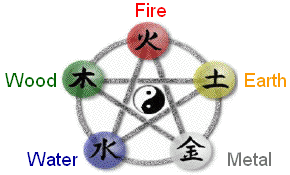Chinese Medicine – The Theory of the Five Elements
Chinese medicine and other Asian health systems, such as the macrobiotic diet, a contemporary adaptation that focuses on eating whole grains and vegetables and avoiding processed or refined foods, draw on the ancient theory of the five elements. This theory appears in the most influential ancient text of Chinese medicine, The Yellow Emperor’s Classic of Medicine, or Nei Jing, written as early as 300 BCE (Ni 1995). Five element theory is based on the close observation of the natural world, and it permeates not only the cuisines but also the literature, art, and belief systems of Asian cultures. The five element cycle describes the changes of seasons and the way that living things are born, grow, flourish, wither, and die in repeating patterns. As you get to know this system, you will be able to observe many examples of these cyclical changes in your life and in the world around you. Attention to the cycle can guide you on a path to wellness and remind you of the healthiest ways to live and eat throughout the year. Each element corresponds to a particular season of the year and to a major internal organ. The five elements are often portrayed as a seasonal cycle, as follows:

To understand and use this system, it is important to grasp some of the differences between Chinese and Western medicine. As you study the above chart, remember that the traditional Chinese understanding of the body organs is quite different from that of Western physiology. It evolved primarily from clinical observation, not dissection. The organs in this system are best thought of as representing not only the physical internal organs but also the entire body system of which they are a part. For example, the spleen in Chinese medicine is the primary organ of digestion, and may be thought of as encompassing the functions of the spleen, stomach, pancreas, and other parts of the digestive tract as it is understood in Western medicine. In all, this is thought of as the energy of the spleen. Note that spleen weakness in the Chinese medicine sense does not necessarily indicate any disorder of the spleen organ in the Western medical sense but instead indicates less than optimal digestive function.
There are five primary internal organs: the heart, spleen, lungs, kidneys, and liver, and each is paired with one or more secondary organs; for example, the stomach is paired with the spleen and the gallbladder with the liver. The internal organs are seen to work synergistically to create the physiological functions of the body. Imbalances in each organ can lead to symptoms and ill health. These imbalances generally fall into one of two types: excess, characterized by hyper function, acute inflammation, and/or congested energy or blood flow; and deficiency, which may entail reduced function, chronic inflammation, structural damage, and/or reduced energy or blood flow.
If you’ve visited a practitioner of Chinese medicine or related arts, you may have been diagnosed, for example, with liver qi congestion, one of the most common imbalances among North American (qi means, essentially, energy). This diagnosis describes a pattern of disharmony or less-than-optimal function, not literally of your liver organ but of the physiological system to which it is connected. Each pattern of excess or deficiency in a particular organ is associated with a characteristic set of signs and symptoms.
The Nei Jing teaches that each of the five elements corresponds to one of the major internal organ system as well as to a particular season. It is beneficial to attend to the health of each organ in its corresponding season. While an imbalance or illness can affect an organ during any season, many health problems can be treated or, better yet, prevented by adjusting the diet – making it more warming or cooling – and by choosing foods to either strengthen or cleanse a particular organ. Following the wheel of the year and echoing the rhythms of nature by choosing seasonal food and preparing it appropriately will ensure that each organ and system is strengthened and cleansed in turn, promoting balanced energy and vitality. The Nei Jing also teaches that it is normal for our energylevels to change throughout the year. Summer, for example, is considered the time of maximum energy and activity levels, while in winter we are advised to go to bed early and rise with the sun, focusing on conserving energy and replenishing ourselves.

